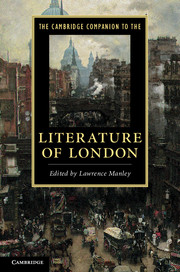Book contents
- Frontmatter
- Introduction
- 1 Images of London in medieval English literature
- 2 London and the early modern stage
- 3 London and the early modern book
- 4 London and poetry to 1750
- 5 Staging London in the Restoration and eighteenth century
- 6 London and narration in the long eighteenth century
- 7 London and nineteenth-century poetry
- 8 London in the Victorian novel
- 9 London in Victorian visual culture
- 10 London in poetry since 1900
- 11 London and modern prose, 1900-1950
- 12 Immigration and postwar London literature
- 13 Writing London in the twenty-first century
- 14 Inner London
- Guide to further reading
- Index
6 - London and narration in the long eighteenth century
Published online by Cambridge University Press: 28 September 2011
- Frontmatter
- Introduction
- 1 Images of London in medieval English literature
- 2 London and the early modern stage
- 3 London and the early modern book
- 4 London and poetry to 1750
- 5 Staging London in the Restoration and eighteenth century
- 6 London and narration in the long eighteenth century
- 7 London and nineteenth-century poetry
- 8 London in the Victorian novel
- 9 London in Victorian visual culture
- 10 London in poetry since 1900
- 11 London and modern prose, 1900-1950
- 12 Immigration and postwar London literature
- 13 Writing London in the twenty-first century
- 14 Inner London
- Guide to further reading
- Index
Summary
As I am now near the Centre of this Work, so I am to describe the great Centre of England, the City of London.
Daniel Defoe, A Tour thro' the Whole Island of Great Britain
London is in fact at the centre of many, many literary works of seventeenth- and eighteenth-century Britain, not just as a setting or backdrop but as a shaping force - of plot, character, and narrative itself. Narrators describe the city, inhabit the city, walk the city, write the city. The circuits Defoe as traveller- narrator takes in his epistolary documentary A Tour thro' the Whole Island of Great Britain (1724-7) begin and end in London, and London is its centrepiece, expanding as we read: 'We see several Villages, formerly standing, as it were, in the Country, and at a great Distance, now joyn'd to the Streets by continued Buildings, and more making haste to meet in the like Manner.' And he draws – or rather, follows – a ‘Line of Measurement’ about the city, a line that actively ‘runs’ and ‘passes’ and ‘crosses’ and ‘turns’ and ‘goes away’ and ‘comes to’:
From Tottenham Court, the Line comes in a little South, to meet the Bloomsbury Buildings, then turning East, runs behind Montague and Southampton Houses, to the N.E . Corner of Southampton House, then crossing the Path, meets the Buildings called Queen’s Square, then turning North, ’till it comes to the N.W. corner of the Square, thence it goes away East behind the Buildings on the North side of Ormond Street, ’till it comes to Lamb’s Conduit. (2.2.99)
- Type
- Chapter
- Information
- The Cambridge Companion to the Literature of London , pp. 102 - 118Publisher: Cambridge University PressPrint publication year: 2011
- 3
- Cited by

